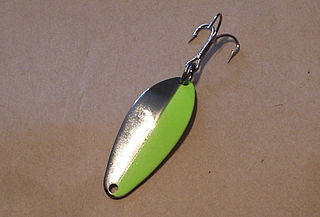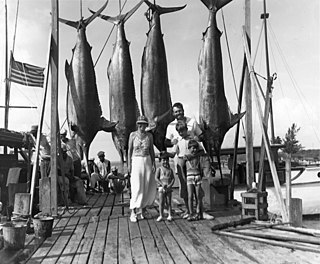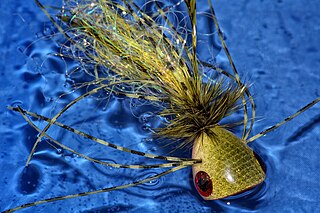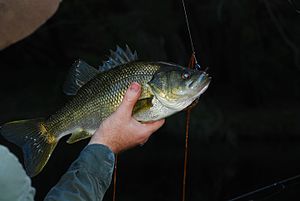
Trolling is a method of fishing where one or more fishing lines, baited with lures or bait fish, are drawn through the water. This may be behind a moving boat, or by slowly winding the line in when fishing from a static position, or even sweeping the line from side-to-side, e.g. when fishing from a jetty. Trolling is used to catch pelagic fish such as salmon, mackerel and kingfish.

Fly fishing is an angling technique that uses a ultralight-weight lure called an artificial fly, which typically mimics small invertebrates such as flying and aquatic insects to attract and catch fish. Because the mass of the fly lure is insufficient to overcome air resistance, it cannot be launched far using conventional gears and techniques, so specialized tackles are used instead and the casting techniques are significantly different from other forms of angling. It is also very common for the angler to wear waders, carry a hand net, and stand in the water when fishing.

Angling is a fishing technique that uses a fish hook attached to a fishing line to tether individual fish in the mouth. The fishing line is usually manipulated via a fishing rod, although rodless techniques such as handlining also exist. Modern angling rods are usually fitted with a fishing reel that functions as a cranking device for storing, retrieving and releasing out the line, although Tenkara fishing and traditional cane pole fishing are two rod-angling methods that do not use any reel. The fish hook itself can be additionally weighted with a denser tackle called a sinker, and is typically dressed with an appetizing bait to attract and entice the fish into swallowing the hook, but sometimes an inedible fake/imitation bait with multiple attached hooks is used instead of a single hook with edible bait. Some type of bite indicator, such as a float, a bell or a quiver tip, is often used to relay underwater status of the hook to the surface and alert the angler of a fish's presence.

Big-game fishing, also known as offshore sportfishing, offshore gamefishing or blue-water fishing, is a form of recreational fishing targeting large game fish, usually on a large body of water such as a sea or ocean.

A fishing lure is a broad type of artificial angling baits that are replicas designed to mimic real prey animals and attract the attention of predatory fish, using appearances, flashy colors, bright reflections, movements, vibrations and/or loud noises to appeal to the fish's predation instinct and entice it into striking.

In sport fishing, a spoon lure is a fishing lure usually made of lustrous metal and with an oblong, usually concave shape like the bowl of a spoon. The spoon lure is mainly used to attract predatory fish by specular reflection of light, as well as the turbulences it creates when moving in water.

Marlin fishing or billfishing is offshore saltwater game fishing targeting several species of fast-swimming pelagic predatory fish with elongated rostrum collectively known as billfish, which include those from the families Istiophoridae and Xiphiidae (swordfish). It is considered by some fishermen to be a pinnacle of big-game fishing, due to the size, speed and power of the billfish and their relative elusiveness.

A spinnerbait or spinner is any one of a family of hybrid fishing lures that combines the designs of a swimbait with one or more spoon lure blades. Spinnerbaits get the name from the action of the metallic blades, which passively revolve around the attachment point like a spinning propeller when the lure is in motion, creating varying degrees of vibration and flashing that mimic small fish or other preys of interest to large predatory fishes. The two most popular types of spinnerbaits are the in-line spinner and safety pin spinnerbait, though others such as the tail spinner also exist. Spinnerbaits are used principally for catching freshwater fishes such as perch, pike and bass.

Fishing tackle is the equipment used by anglers when fishing. Almost any equipment or gear used in fishing can be called fishing tackle, examples being hooks, lines, baits/lures, rods, reels, floats, sinkers/feeders, nets, spears, gaffs and traps, as well as wires, snaps, beads, spoons, blades, spinners, clevises and tools that make it easy to tie knots.

In Britain and Ireland, coarse fishing refers to angling for rough fish, which are fish species traditionally considered undesirable as a food or game fish. Freshwater game fish are all salmonids — most particularly salmon, trout and char — so generally coarse fish are freshwater fish that are not salmonids. There is disagreement over whether grayling should be classified as a game fish or a coarse fish.

A topwater fishing lure or walker is a type of surface fishing lure, usually floating just at the water surface, that may be moved about the surface of water in order to attract and cause fish to attempt to strike the lure. Non-floating versions may be retrieved at sufficient speed to cause them to travel at the water's surface.
A bass worm is an artificial fishing lure which comes in a variety of different colors and body types and is usually scented with a salty, garlic residue. Bass worms are more effective than other rubber worms primarily because bass are attracted to a particular worm depending on the environment in which they are being used.

Plugs are a popular type of hard-bodied fishing lure. They are widely known by a number of other names depending on the country and region. Such names include crankbait, wobbler, minnow, shallow-diver and deep-diver. The term minnow is usually used for long, slender, lures that imitate baitfish, while the term plug is usually used for shorter, deeper-bodied lures which imitate deeper-bodied fish, frogs and other prey. Shallow-diver and deep-diver refer to the diving capabilities of the lure, which depends on the size and angle of the lip, and lure buoyancy.

Soft plastic bait, commonly known as soft lure, soft plastics, plastic bait, worm lure or just worm, is any of a range of elastomer-based fishing lures termed so because of their flexible, flesh-like texture. Soft lures are available in a large range of colours, sizes and particularly shapes, and are typically impaled directly onto a fishing hook like an ordinary bait.

An artificial fly or fly lure is a type of fishing lure, usually used in the sport of fly fishing. In general, artificial flies are an imitation of aquatic insects that are natural food of the target fish species the fly fishers try to catch. Artificial flies are constructed by fly tying, in which furs, feathers, thread or any of very many other materials are tied onto a fish hook.

Spin fishing is an angling technique where a spinnerbait, a type of hybrid fishing lure with at least one freely rotating blade, is used to entice the fish to bite. When the line is reeled back, the spinnerbait blades will spin passively with oncoming the water flow, in turn stirring up significant amount of turbulence and noise, which transmit through the water and provoke predatory fish to strike the lure out of their foraging as well as territorial instincts. Spin fishing is used in both freshwater and marine environments.

Fishing techniques are methods for catching fish. The term may also be applied to methods for catching other aquatic animals such as molluscs and edible marine invertebrates.

The popper is an effective and proven lure designed to move water using a concave or hollowed nose. Poppers aim to simulate any sort of distressed creature that might be moving or struggling on the surface of the water. Poppers are used with spin fishing and fly fishing.
Swimbaits or swimmers are a loosely defined class of fishing lures that are designed to primarily imitate the underwater swimming motions of baitfishes.
Kite fishing, a fishing technique. It involves a kite from which a drop line hangs, attached to a lure or bait. The kite is flown over the surface of a body of water, and the bait floats near the waterline until taken by a fish. The kite then drops immediately, signaling to the fisherman that the bait has been taken, and the fish can then be hauled in. Kites can provide boatless fishermen access to waters that would otherwise be available only to boats. Similarly, for boat owners, kites provide a way to fish in areas where it is not safe to navigate - such as shallows or coral reef.



















